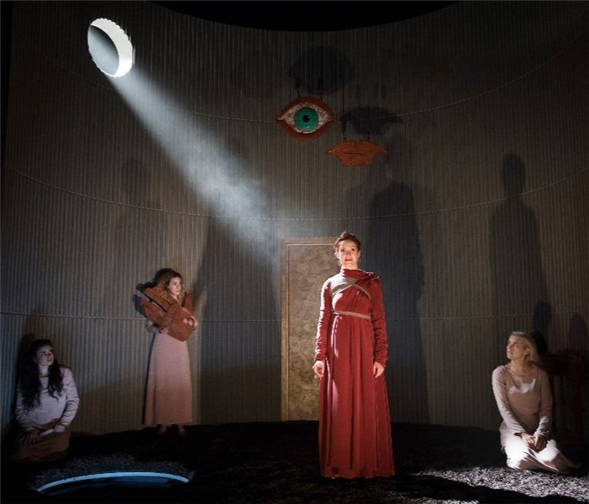Translate Page

Grace McLean on her unconventional new musical about the groundbreaking Hildegard von Bingen
---
Writer-performer Grace McLean has made a career out of appearing in period pieces. In Natasha, Pierre & the Great Comet of 1812, she played the ingénue's godmother, Marya D., a grand dame of 19th-century Russia. In Alice By Heart, a 1940s London-set riff on Alice in Wonderland, she was a Red Cross Nurse-turned-Red Queen. But for In the Green, her world-premiere chamber musical commissioned by Lincoln Center Theater's LCT3, she's going way back in time to 12th-century Germany to tell the origin story of real-life saint Hildegard von Bingen, one of the Middle Ages' most influential women.
In addition to penning the show's book, lyrics and music, McLean plays Jutta von Sponheim, Hildegard's mentor, though theirs is not a traditional teacher-student situation. As a child, Hildegard was given to the Catholic Church as an oblate and put in the care of Jutta, an anchoress who chose to lock herself in a cell and dedicate her life to God. They were entombed together for 30 years until Jutta's death, at which point Hildegard emerged and blossomed into a renowned writer, composer, philosopher, naturalist and visionary.
Yet McLean wasn't interested in exploring her many well-documented accomplishments; it was Hildegard's mysterious, multi-decade relationship with Jutta that ignited her creative spark. "There's so much that's amazing about Hildegard and all of the things she created in a time when there was no way for women to be making the things that she was making," McLean says. "But nobody talks about that first bit of her life: the 30 years she spent in a cell with this other woman. Something must have happened between them, so that's where we start."
Under the direction of Lee Sunday Evans, the all-women cast gives a vivid sense of the power struggles that may have taken place inside that claustrophobic room. A four-person band plays McLean's eclectic songs, which fuse elements of jazz, folk, a cappella chanting and pop, and even incorporate some of Hildegard's liturgical music. "Music was Hildegard's language," McLean explains. "She said, 'I don't care about the rules. I'm going to write what feels right for this moment.' So I gave myself permission to do the same. Her music gave me permission to play with some nontraditional techniques and some weird sounds."
{Image1}
Many of those unusual noises are the product of looping technology. During the performance, McLean uses a handheld remote to loop her own vocals on command, creating a layered aural landscape. She enlisted Great Comet sound designer Nicholas Pope to help her figure out a way to execute the complex process live, so McLean is able to tell the sound board when to record, play and mute her various vocal tracks. She pairs each press of the button with a dramatic choreographed movement that mimics a religious gesture somewhere between genuflection and self-flagellation -- a distinct nod to Jutta's devotion.
McLean's use of looping started out as a practical way to compose music. "I'm not a good enough or fast enough musician on other instruments to be able to write that way, but I know how to use my voice as an instrument and the looper allows me to build on it and amplify it and manipulate it," she explains. But as she developed In the Green, she realized the technique was dramaturgically sound, too. Just like Jutta, "it's very self-contained and self-reliant," she says. "For the character to be able to use her voice and only her voice to tell the story makes sense."
On the other hand, McLean enlisted three performers to play Hildegard, each taking on a different element of her fractured psyche. Instead of one voice looped over itself, three separate voices sing together -- often in harmony, sometimes in dissonance.
Since there's little record of what Jutta and Hildegard did inside their chamber all those years, McLean was able to invent their interactions without worrying about being true to history. The story she's conjured centers around their search for wholeness after traumatic experiences. "I'm trying to look at Jutta's decision to lock herself away from the world as a radical feminist act," McLean says. "Because that was truly the only way at the time that a woman could have any kind of agency, which was to simply say no to all of it. I want to honor that choice in some way."
---
TDF MEMBERS: At press time, discount tickets were available for In the Green. Go here to browse our current offers.
Jen Gushue is a freelance theatre writer with bylines in American Theatre, HowlRound and Business Insider. Follow her on Twitter at @jengushue. Follow TDF at @TDFNYC.
Top image: Ashley Pérez Flanagan, Hannah Whitney, Grace McLean and Rachael Duddy in In the Green. Photos by Julieta Cervantes.